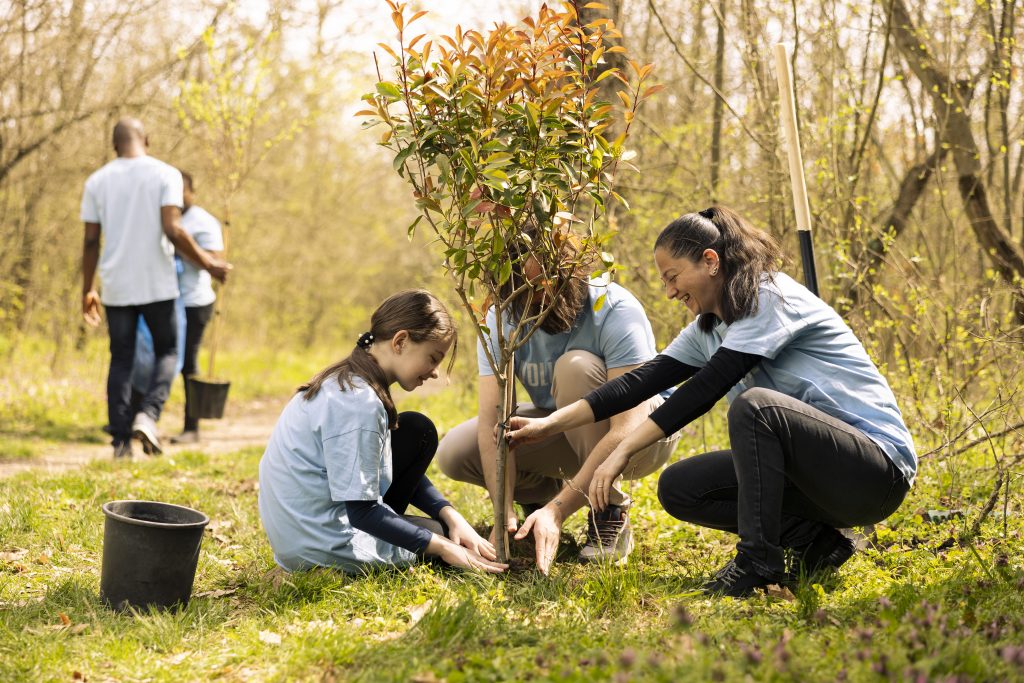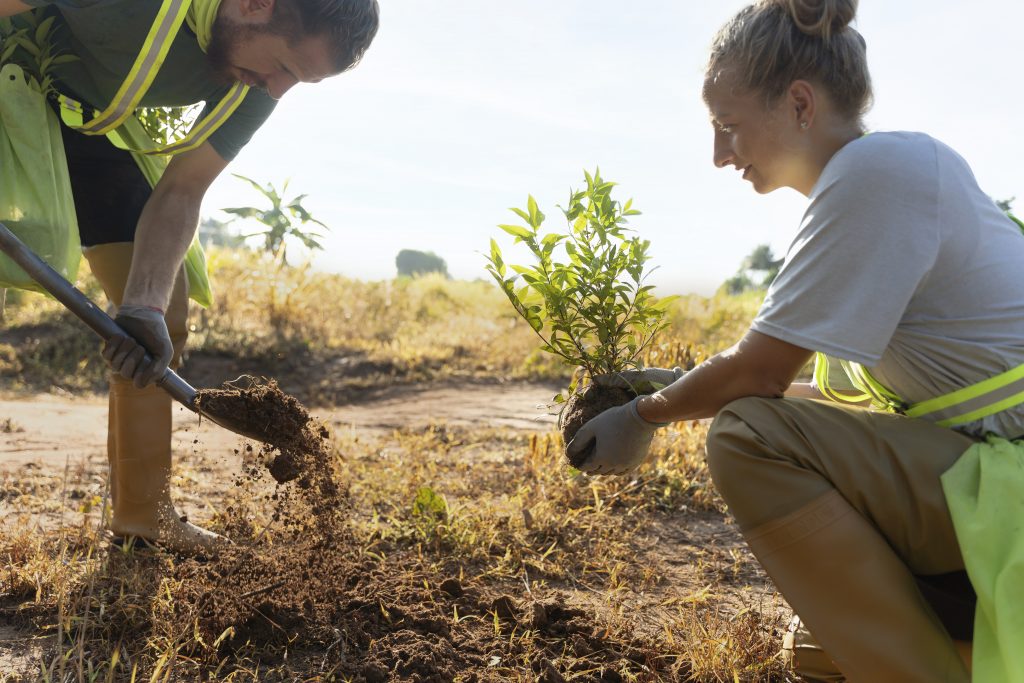Tree planting is the act of deliberately planting tree seedlings or young trees in a specific area, often with the goal of improving the environment, conserving natural resources, and enhancing ecosystems. It is a critical component of reforestation, afforestation, and environmental conservation efforts worldwide. Tree planting can take place in various contexts and for numerous reasons, and its benefits extend to both the environment and society. Here is an explanation of tree planting:

Environmental Benefits:
- Carbon Sequestration: Trees absorb carbon dioxide (CO2) from the atmosphere during photosynthesis and store carbon in their biomass. This process helps mitigate climate change by reducing the concentration of greenhouse gases in the atmosphere.
- Air Quality Improvement: Trees filter out pollutants from the air, including harmful chemicals and particulate matter, leading to improved air quality in urban and rural areas.
- Erosion Control: The root systems of trees help stabilize soil, preventing erosion and reducing the risk of landslides, especially in hilly or sloped terrain.
- Habitat Creation: Trees provide habitats for various wildlife species, supporting biodiversity and ecological balance.
- Water Management: Trees play a role in regulating the water cycle by absorbing and releasing water through transpiration and evaporation. This helps in regulating local climate and reducing the risk of flooding.
Social Benefits:
- Aesthetic Beauty: Trees enhance the visual appeal of landscapes and urban areas, making them more attractive and enjoyable for residents and visitors.
- Recreation and Shade: Urban forests and green spaces created through tree planting provide recreational opportunities for people and offer shaded areas for relaxation and outdoor activities.
- Health Benefits: Access to green spaces and tree-filled environments has been linked to improved mental and physical health for individuals.
- Community Engagement: Tree planting projects often involve community participation, fostering a sense of ownership, pride, and cooperation among residents.
Economic Benefits:
- Timber and Non-Timber Products: Some tree species can be harvested for timber, firewood, or non-timber forest products, providing income and livelihood opportunities.
- Increased Property Values: Areas with well-maintained trees and green spaces tend to have higher property values, benefiting homeowners and local governments.
- Energy Savings: Properly placed trees can reduce energy consumption in buildings by providing shade in summer and windbreaks in winter, leading to lower heating and cooling costs.
Reforestation and Restoration:
- Reforestation: Tree planting is crucial for restoring areas that have been deforested or damaged by wildfires, logging, or natural disasters.
- Afforestation: Afforestation involves planting trees in areas that were not previously forested, such as degraded lands or urban spaces.
Tree planting is a proactive and sustainable approach to address environmental challenges, promote biodiversity, enhance community well-being, and combat climate change. It is a practice that requires careful planning, maintenance, and long-term commitment to ensure the successful growth and survival of trees for generations to come.
Importance Of Tree Planting
Tree planting is of paramount importance due to its numerous environmental, social, and economic benefits. Here’s a detailed explanation of why tree planting is crucial:
- Climate Change Mitigation:
- Carbon Sequestration: Trees absorb carbon dioxide (CO2) during photosynthesis and store carbon in their biomass. This helps reduce the concentration of greenhouse gases in the atmosphere, mitigating climate change.
- Cooling Effect: Trees provide shade and release water vapor through transpiration, which cools the air and reduces the urban heat island effect, combating rising temperatures.
- Biodiversity Conservation:
- Habitat Creation: Trees provide homes and food for a wide variety of wildlife species, supporting biodiversity and maintaining ecological balance.
- Wildlife Corridors: Forested areas serve as wildlife corridors, allowing animals to move between habitats and promoting genetic diversity.
- Air Quality Improvement:
- Pollutant Filtration: Trees filter out pollutants and particulate matter from the air, leading to improved air quality and reduced respiratory issues for humans.
- Soil Protection:
- Erosion Control: Tree root systems help stabilize soil, preventing erosion and reducing the risk of landslides, particularly in hilly or sloped areas.
- Water Resource Management:
- Water Regulation: Trees play a crucial role in regulating the water cycle by absorbing and releasing water through transpiration and evaporation. This reduces the risk of flooding and ensures a more consistent water supply.
- Economic Benefits:
- Timber and Non-Timber Products: Some tree species can be harvested for timber, firewood, or non-timber forest products, providing income and livelihood opportunities.
- Increased Property Values: Well-maintained trees and green spaces can lead to higher property values, benefiting homeowners and local governments.
- Energy Savings: Properly placed trees can reduce energy consumption in buildings by providing shade in summer and windbreaks in winter, leading to lower heating and cooling costs.
- Social and Health Benefits:
- Aesthetic Beauty: Trees enhance the visual appeal of landscapes and urban areas, making them more attractive and enjoyable for residents and visitors.
- Recreation and Shade: Urban forests and green spaces created through tree planting provide recreational opportunities and shaded areas for relaxation and outdoor activities.
- Health Benefits: Access to green spaces and tree-filled environments has been linked to improved mental and physical health for individuals.
- Community Engagement: Tree planting projects often involve community participation, fostering a sense of ownership, pride, and cooperation among residents.
- Reforestation and Restoration:
- Reforestation: Tree planting is crucial for restoring areas that have been deforested or damaged by wildfires, logging, or natural disasters.
- Afforestation: Afforestation involves planting trees in areas that were not previously forested, such as degraded lands or urban spaces.
In summary, tree planting is essential for addressing a wide range of global challenges, including climate change, biodiversity loss, air and water pollution, soil erosion, and urbanization. It provides a sustainable and cost-effective way to improve the environment, enhance human well-being, and secure a better future for generations to come.
Benefits To The Community And Environment
Tree planting offers a multitude of benefits to both the community and the environment. These benefits are interrelated and contribute to the overall well-being of society and the planet. Here are the key advantages for both:

Benefits to the Community:
- Improved Aesthetic and Quality of Life: Well-planted trees enhance the beauty and aesthetics of neighborhoods and public spaces, making them more visually appealing and enjoyable for residents.
- Recreation and Relaxation: Tree-lined streets, parks, and green spaces provide opportunities for recreational activities, relaxation, and social gatherings, promoting physical and mental health.
- Healthier Living: Trees improve air quality by filtering out pollutants, reducing the risk of respiratory illnesses, and promoting a healthier living environment.
- Increased Property Values: Homes and properties surrounded by trees often have higher market values, benefiting homeowners and increasing local tax revenue.
- Noise Reduction: Trees act as natural sound barriers, reducing noise pollution from traffic and urban activities, creating quieter and more peaceful neighborhoods.
- Energy Savings: Strategically planted trees around buildings can provide shade in summer, reducing cooling costs, and act as windbreaks in winter, lowering heating expenses.
- Community Engagement: Tree planting projects involve local residents, fostering a sense of community pride, ownership, and cooperation among neighbors.
- Educational Opportunities: Tree planting initiatives can serve as valuable educational experiences for schools, teaching students about environmental stewardship and ecology.
Benefits to the Environment:
- Carbon Sequestration: Trees absorb and store carbon dioxide (CO2) from the atmosphere during photosynthesis, helping mitigate climate change by reducing greenhouse gas concentrations.
- Biodiversity Support: Trees provide habitats and food for a wide range of wildlife species, supporting biodiversity and ecological balance.
- Air Quality Improvement: Trees filter pollutants and particulate matter from the air, leading to cleaner and healthier air for all living organisms.
- Soil Conservation: Tree root systems help prevent soil erosion, preserving valuable topsoil and reducing the risk of landslides.
- Water Management: Trees play a critical role in regulating the water cycle by absorbing and releasing water through transpiration and evaporation, reducing flooding and maintaining consistent water supply.
- Natural Resource Conservation: Some tree species can be harvested for timber, firewood, and non-timber forest products, contributing to sustainable resource management.
- Erosion Control: Trees protect riverbanks and coastal areas from erosion, preserving vital ecosystems and preventing property damage.
- Climate Regulation: The shade provided by trees reduces local temperatures, mitigating the urban heat island effect and helping to stabilize regional climates.
In summary, tree planting not only enhances the quality of life for communities by creating healthier and more beautiful living environments but also contributes significantly to the conservation of natural resources and the mitigation of environmental challenges like climate change and biodiversity loss. It represents a sustainable and inclusive approach to building more resilient and harmonious communities while safeguarding the planet’s ecosystems.
If you need a tree service in Utah, you can call:
Truco Services, Inc.
4640 Commerce Drive
Murray, Utah 84107
(801) 466–8044
https://truetreeservices.com/

